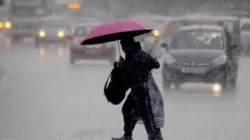Delhi-NCR wakes up to drizzle, IMD issues orange alert | Check weather forecast
The weatherman had also predicted light to medium rainfall in Delhi-NCR, Punjab, Haryana and parts of Rajasthan mainly for March 1 and 2. In addition, thunderstorms and gusty winds along with hailstorms have also been predicted in isolated places for March 2.

Delhittes woke to a drizzle on Saturday while the India Meteorological Department issued an orange alert for rainfall. The National Capital region witnessed a decrease in minimum temperatures. Meanwhile, showers have been predicted throughout the day.
The national capital's minimum temperature settled five notches above normal at 18.2 degree Celsius, the India Meteorological Department said. Meanwhile, the maximum temperature is likely to settle around 22 degree Celsius. At 8.30 am, the humidity level was recorded at 76 per cent.
The national capital's Air Quality Index (AQI) was recorded in the 'moderate' category at 9 am with a reading of 148, according to Central Pollution Control Board data. An AQI between zero and 50 is considered 'good', 51 and 100 'satisfactory', 101 and 200 'moderate', 201 and 300 'poor', 301 and 400 'very poor', and 401 and 500 'severe'.
Taking to social media platform X, the state weather department wrote, "Light to moderate intensity rain and gusty winds with speed of 30-50 Km/h would occur over and adjoining areas of most places of Delhi, NCR, Haryana and North India."
Snowfall to continue in Jammu and Kashmir
Earlier, IMD had issued an orange alert for heavy to very heavy snowfall in the Northernmost regions of the country till March 3. The weatherman had also predicted light to medium rainfall in Delhi-NCR, Punjab, Haryana and parts of Rajasthan mainly for March 1 and 2. In addition, thunderstorms and gusty winds along with hailstorms have also been predicted in isolated places for March 2.
Why is the weather turning chilly again?
The main reason for the weather turning chilly is the receding Western Disturbance. The weather department had predicted earlier, that clouds have begun entering the Indian region due to Western Disturbance.
ALSO READ | IMD predicts heavy snowfall in J-K, North India likely to receive rain | Check details